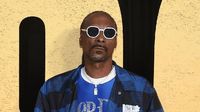Rapper Snoop Dogg has found himself at the center of a heated debate over LGBTQ representation in children’s media after his candid remarks about Disney and Pixar’s 2022 animated film Lightyear sparked widespread backlash—and ultimately, a public apology. The controversy, which erupted after Snoop’s appearance on the “It’s Giving” podcast, has become a flashpoint in the ongoing national conversation about how and when children are introduced to diverse family structures on screen.
On August 20, 2025, Snoop Dogg, 53, appeared on Dr. Sarah Fontenot’s “It’s Giving” podcast and recounted an experience that left him unsettled: taking his grandchildren to see Lightyear, only to be caught off guard by questions about a same-sex couple featured in the film. The movie, a spinoff from the beloved Toy Story franchise, includes a brief but notable montage in which space ranger Alisha Hawthorne (voiced by Uzo Aduba) marries her partner Kiko, raises a child, and shares what became Disney’s first on-screen same-sex kiss. For Snoop, the scene prompted a barrage of questions from his grandson: “Papa Snoop? How she have a baby with a woman? She’s a woman!”
“I didn’t come in for this shit,” Snoop said on the podcast, expressing both confusion and frustration. “Y’all throwing me in the middle of shit that I don’t have an answer for… I’m scared to go to the movies.” He continued, “These are kids. We have to show that at this age? They’re going to ask questions. I don’t have the answer.” According to The Hollywood Reporter, Snoop tried to redirect his grandson, telling him, “Hey man, just watch the movie,” but the questions kept coming. “It fucked me up,” the rapper admitted. “I’m like, scared to go to the movies now.”
Snoop’s remarks quickly ignited a firestorm online. Critics accused him of homophobia and ignorance, with some pointing to a history of controversial statements regarding the LGBTQ community. Among the most vocal was trans reality star TS Madison, who publicly challenged Snoop’s stance—highlighting the perceived double standard between his music videos, which have featured women kissing, and his discomfort with same-sex representation in a children’s film.
Screenwriter Lauren Gunderson, who contributed to Lightyear, also weighed in on social media. Defending the inclusion of the queer couple, Gunderson wrote, “As small as that detail is in the film, I knew the representational effect it could have. Small line, big deal. I was elated that they kept it.” She added, “Beautiful love like this exists. It’s not fiction. What IS fiction is Zurg and lightspeed space travel and murderous aliens and a talking robot cat (long live Sox).” Gunderson’s comments underscored the view that LGBTQ representation in children’s media is not only natural but necessary.
The backlash was swift and, for some, deeply personal. Social media users resurfaced Snoop Dogg’s 2004 cameo on Showtime’s lesbian drama The L Word, where he appeared alongside Jennifer Beals. The scene, now circulating widely online, was used by critics to highlight what they saw as contradictions in Snoop’s public persona. Others pointed to previous controversies, including a 2014 Instagram post in which Snoop used a homophobic slur and shared a meme about Caitlyn Jenner that many labeled transphobic.
Amid mounting criticism, Snoop Dogg responded on August 27, 2025, in the comments of a Hollywood Unlocked Instagram post. He acknowledged his discomfort and lack of preparedness, writing, “I was just caught off guard and had no answer for my grandsons. All my gay friends [know] what’s up, they been calling me with love. My bad for not knowing the answers for a 6-yr-old. Teach me how to learn. I’m not perfect.” Snoop further clarified, “All my gay friends know I support the LGBTQ community.”
His apology, while welcomed by some, did little to quell the broader debate. Several media personalities, including the hosts of “The Breakfast Club,” defended Snoop’s initial concerns. DJ Envy remarked, “I don’t want to have to explain any of this in a cartoon or a movie if I’m taking my child.” Co-host Charlamagne tha God argued that critics should have used the moment as a teaching opportunity rather than attacking Snoop, suggesting that the incident could have sparked a more constructive dialogue about how to talk to children about LGBTQ issues.
The controversy comes at a time when entertainment companies are under increasing scrutiny for their handling of LGBTQ themes in family programming. Lightyear’s same-sex kiss was initially cut from the film but later restored after internal outcry from Pixar staff, as reported by The Blast. The decision led to the movie being banned in 14 countries, highlighting the global divide over such content. Since 2022, Disney and Pixar have reportedly scaled back LGBTQ themes in children’s content, allegedly rewriting scripts and cutting storylines to avoid controversy.
This tug-of-war reflects the complex balancing act studios face: advocating for inclusive representation while addressing parental concerns about age-appropriate material. Proponents of LGBTQ visibility argue that diverse family structures deserve to be seen and normalized, especially for young viewers who may themselves come from or encounter such families. Critics, however, worry that such portrayals force parents into difficult conversations for which they may feel unprepared, or that they introduce topics they believe are inappropriate for certain age groups.
As the dust settles, Snoop Dogg’s willingness to apologize and ask for guidance may offer a glimmer of hope for more nuanced discussions in the future. His words—“Teach me how to learn. I’m not perfect”—signal an openness that some advocates see as essential for bridging divides. At the same time, the incident has reignited questions about whether entertainment should lead or follow societal conversations about LGBTQ issues, and how best to support both representation and parental agency.
For now, the debate over Lightyear and Snoop Dogg’s reaction serves as a potent reminder of the challenges and opportunities that come with expanding the stories we tell—and the audiences we hope to reach.



